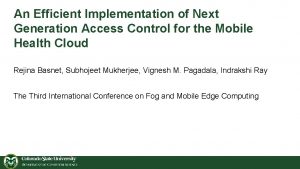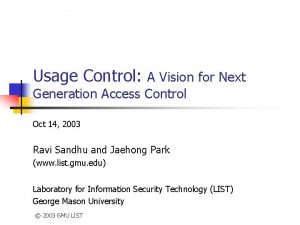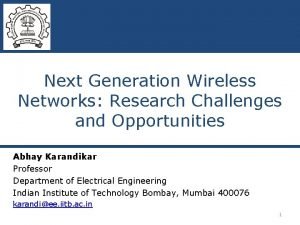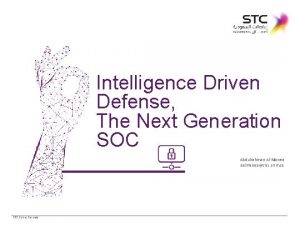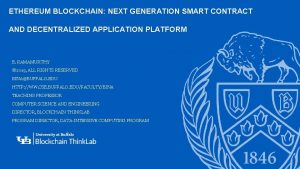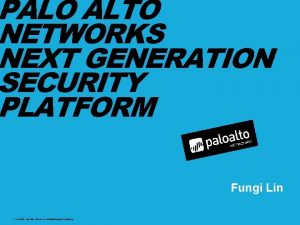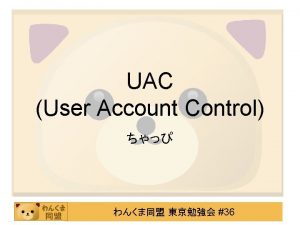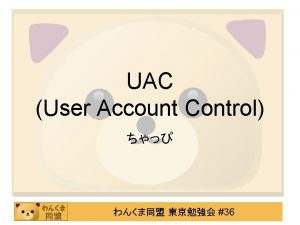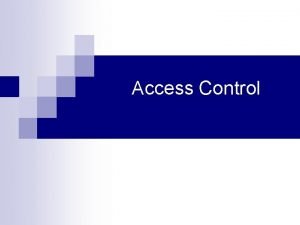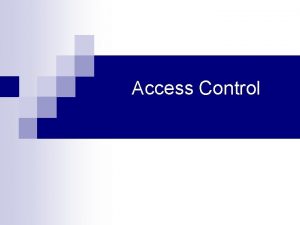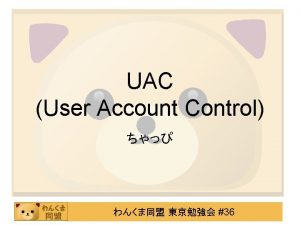An Efficient Implementation of Next Generation Access Control























- Slides: 23

An Efficient Implementation of Next Generation Access Control for the Mobile Health Cloud Rejina Basnet, Subhojeet Mukherjee, Vignesh M. Pagadala, Indrakshi Ray The Third International Conference on Fog and Mobile Edge Computing

What is m. Health? ➢m. Health technology has begun to gain traction due to advances in information technology and mobile-computing. ➢An m. Health system is basically one which involves the use of mobile computing devices in discharging healthcare-related services.

m. Health System Architecture Physician - Sensor node Body-area network Insurance company agent - Mobile node Researcher Health Records System Patient

Problem Description Physician Access control enforcement point - Sensor node Body-area network Insurance company agent - Mobile node Researcher Health Records System Patient

m. Health System Requirements ➢Effective policy representation and enforcement. ➢Fine-grained data access. ➢Fast access decisions.

Limitations of the Existing System ➢ RBAC and XACML-based ABAC are used in conventional m. Health systems. ➢ Limitations of RBAC: ○ A sizeable organization might have many roles, which makes role management difficult. ○ Is incapable of achieving finer levels of granularity. ➢ Limitations of XACML: ○ Slow in making access decisions.

Data Model ➢ We consider our data to consist of 4 features: Patient ID, Date-Time, Calories and Steps Taken, which are taken from a simulated Fit. Bit dataset. [Furberg, R. D. (2015). Self-generated Fitbit dataset 10. 22. 2011 -09. 2014 [Data set]. Zenodo. http: //doi. org/10. 5281/zenodo. 14996]

Threat Model ➢Sources of Threats: ○ Patient (the patient himself or herself) ○ Internal (someone already with authorized access) ○ External (someone without authorized access) ➢Vulnerable Assets: ○ Mobile Internet Device ○ Sensor Nodes ○ Preprocessing Unit ○ Health Record System ➢ Possible risks ○ Data quality and integrity ○ Patient confidentiality ○ Availability of data

Proposed Approach ➢ Our solution is based upon NIST Policy Machine (PM). ○ PM can effectively represent m. Health-based policies. ○ Fine-grained access control can be achieved. ○ Usage of existing or new graph theoretic approaches can speed up access decisions. ➢ Neo 4 j graph database is used for implementation. ○ Persistent storage of data and access control policies, with relevant indexing. ○ Native storage and processing allows constant time object access. ○ Can easily integrate with most complex graph search and reachability algorithms.

Solution Architecture Physician NIST NGAC enforcement point - Sensor node Body-area network Insurance company agent - Mobile node Health Records System N G A C Researcher Patient

Proposed PM Template ➢ Subjects can include, but are not restricted to ○ Physicians, patient, insurance companies and lawyers. ➢ Subject attributes can include, but are not restricted to ○ Role: Physicians, patient, insurance companies and lawyers ➢ The objects are individual fields of a patient’s data, as received from the Mobile Node. ○ Eg. Calorie recordings at a given time instance. ➢ Object attributes can include, but are not restricted to ○ Owner: Patient ID ○ Type: Calories, Steps ○ Time: Time at which the data instance was collected. ➢ The Administrator is responsible assigning actual access rights.

Example Policy ➢ The doctor u 5 is allowed read access to patient u 2’s ‘steps’ on the date ‘aa/bb/cc’. ➢ The researchers u 3 and u 4 are allowed read access to all fitness-data features of all patients.

Technical Challenges Construction of the PM graph: ○ Adding nodes and edges ■ Objects and object attributes obtained from incoming traffic. ■ Users and user attributes are collected from an access portal. ■ Administrator is responsible for adding associations in the PM graph. ○ Index construction ■ User and object nodes are indexed with reachable operation nodes. ■ Operations nodes are indexed with reachable source nodes.

Technical Challenges Types of access requests: ➢ Query of type <u, op, o>: Can Dr Jekyll read the patient Mr Hyde’s data? ➢ Query of the type <u, *, *>: What privileges does user u have?

Implementation Architecture 4. User ID Body-area network Researcher 3. User ID, Attributes 2. Attributes Registration portal Policy machine graph database 1. ownerid, calories = xx, steps = yy 2. Attributes Physician 4. User ID 5. Access Request Access portal Request Can I access X’s calorie data? What access rights do I have? 6. Request (u, op, p) (u, *, *) 1. Policies 7. Requested Data (after policy evaluation) Data Administrator

Evaluation of <u 1, op 2, o 1> Step 1 Get indexes of u 1 op 1 oa 3 ua 3 op 2 ua 1 u 1 oa 4 ua 2 oa 1 oa 2 op 3 ua 5 In this case, they are {op 1, op 2, op 4} oa 5 op 4 o 1

Evaluation of <u 1, op 2, o 1> Step 2 Get indexes of o 1 op 1 oa 3 ua 3 op 2 ua 1 u 1 oa 4 ua 2 oa 1 oa 2 op 3 ua 5 In this case, they are {op 2, op 3, op 4} oa 5 op 4 o 1

Evaluation of <u 1, op 2, o 1> Step 3 Get intersection of both the indexes. op 1 op 2 ua 1 u 1 oa 3 ua 3 oa 4 ua 2 oa 1 oa 2 op 3 ua 5 Intersection is {op 2, op 4}. Since op 2 belongs to this set, access is granted to u 1 to perform operation op 2 on object o 1. oa 5 op 4 o 1

Evaluation of <u 1, *, *> Step 1 Traverse through all op nodes. {op 1, op 2, op 3, op 4} op 1 op 2 ua 1 u 1 oa 3 ua 3 oa 4 ua 2 oa 1 oa 2 op 3 ua 5 op 4 For each op node, perform binary search through reachable user nodes. If u 1 is found, return the indexed object list. In this case, no object nodes so we return nothing. o 1

Evaluation of <u 1, *, *> Step 2 Traverse through all op nodes. {op 1, op 2, op 3, op 4} op 1 op 2 ua 1 u 1 oa 4 ua 2 oa 5 op 4 o 1 oa 2 op 3 ua 5 Return {op 2, o 1} oa 3 ua 3

Evaluation of <u 1, *, *> Step 3 Traverse through all op nodes. {op 1, op 2, op 3, op 4} op 1 op 2 ua 1 u 1 oa 4 ua 2 oa 5 op 4 o 1 oa 2 op 3 ua 5 Return {} oa 3 ua 3

Evaluation of <u 1, *, *> Step 4 Traverse through all op nodes. {op 1, op 2, op 3, op 4} op 1 op 2 ua 1 u 1 oa 4 ua 2 oa 5 op 4 o 1 oa 2 op 3 ua 5 Return {op 4, o 1} oa 3 ua 3

Future Work ➢ Delegate permission assignments to data owners and important stakeholders. ○ In PHR systems user’s have administrative control over their records. ○ In EHR systems hospitals/doctors can also have administrative control. ➢ Use O-auth/Open. ID Connect based authentication and authorization schemes to confirm initial access requests. ➢ Integrate spatio-temporal access control ○ Catered to m. Heatlh systems.
 Next generation access control
Next generation access control Usage control model
Usage control model X.next = x.next.next
X.next = x.next.next Productively efficient vs allocatively efficient
Productively efficient vs allocatively efficient Productively efficient vs allocatively efficient
Productively efficient vs allocatively efficient C b a d
C b a d Allocative efficiency vs productive efficiency
Allocative efficiency vs productive efficiency Productively efficient vs allocatively efficient
Productively efficient vs allocatively efficient Efficient signature generation by smart cards
Efficient signature generation by smart cards Terminal access controller access control system plus
Terminal access controller access control system plus Terminal access controller access-control system
Terminal access controller access-control system First generation antipsychotics
First generation antipsychotics God you are good and your mercy endureth forever
God you are good and your mercy endureth forever Palo alto traps gartner
Palo alto traps gartner Global next generation wireless communication market
Global next generation wireless communication market Clinical judgement model
Clinical judgement model Next generation soc
Next generation soc Next-generation smart contracts
Next-generation smart contracts Next generation vaccine
Next generation vaccine Vendor selection matrix
Vendor selection matrix Next generation learning platform
Next generation learning platform Sinkhole palo alto
Sinkhole palo alto What is next generation text service
What is next generation text service Next generation nclex 2019
Next generation nclex 2019
